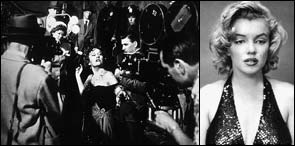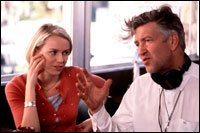| |
 |
|
|
In Mulholland Drive, David
Lynch is as intrigued by the surreal as he is haunted by old
Hollywood. In his Manifeste du Surréalisme, the surrealist
visionary and poet, André Breton insists : “La peur,
l’attrait de l’insolite, les chances, le goût du luxe sont
ressorts auxquels on ne fera jamais appel en vain” [“Fear,
the attraction of the unusual, chance, the taste for things
extravagant are all devices which we can call upon without
fear of disappointment”] (2). He argues that these attributes
of fantasy and dark romanticism are qualities of the surreal.
The poet Tristan Tzara also praised “l’amour des fantômes,
des sorcelleries, de l’occultisme, de la magie, du vice, du
rêve, des folies, des passions, du folklore (...) de la mythologie,
des utopies sociales (...) des voyages réels ou imaginaires
(...) des merveilles...” [“the love of ghosts, spells,
the occult, magic, vice, dreams, madness, passions, folklore
(...) mythology (...) social utopias (...) real or imaginary
journeys (...) marvels”] (3). David Lynch’s interest in
surrealism is manifested in his love of suspense and chance
and in his obsession with the marvellous and unusual. Fear
and wonder pervade Lynch’s Hollywood as it is also populated
by a bizarre and enigmatic humanity. It is in reference to
Hollywood and the surreal in particular that I will first
explore the dream narrative and extended nightmarish climax
of Mulholland Drive.
The Desirous Actress and the
Dream Narrative : The Role of the Mythic and the Surreal
 |
|
|
|
Mulholland Drive
opens with a scene of silhouetted, jitterbugging couples encroached
by the washed out, hallucinogenic smears of a young blonde
woman in the spotlight and adored. She is both flanked by
an old couple - her parents ? the judges of the contest ?
- and alone. The purples and blues of the background prefigure
the colours of night sky and bruising we will soon see. This
is followed by a shot of a bed while the sound of breathing
vibrates on the soundtrack. As the camera merges with the
pink pillow, we are almost smothered into sleep. What follows
is the young blonde woman’s extraordinary dream of love, erotic
power and promise in Hollywood and her descent into its weird
abyss through romantic disappointment and career failure.
Such is the central narrative of Mulholland Drive.
The actress is played by the exceptional Naomi Watts. She
is both the fair and promising actress Betty and the washed-out,
failed actress Diane. The blonde woman’s desirable self, the
gifted and adored Betty, the heroine of Mulholland’s
dream narrative, becomes the degraded, murderous Diane of
Mulholland’s waking narrative or consciousness. Rita,
the beloved of Betty, played by Laura Elena Harring, becomes
Camilla (again played by Harring), Diane’s movie star lover
and victim. Thus, the iridescent dream of Hollywood becomes
a luscious nightmare where an actress loves another and where
the actress is corrupted by a bizarre, masculinist industry
which crafts and destroys her life. We will see that the actress
in Lynch’s Hollywood is both victim and executioner.
|